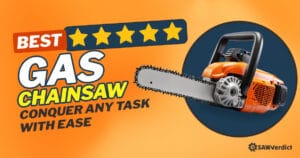Chainsaw safety is essential to avoid bad injuries. Each year, about 23,000 people get hurt using chainsaws. Around 76% of these injuries are cuts, and 40% harm legs or knees. Using a chainsaw the wrong way can be hazardous. Falling trees or branches can even cause death. Over 80% of injuries happen to arms or legs. Wearing safety gear and being careful can help a lot. Always focus on safety so tree cutting stays safe and accident-free.
Key Takeaways
- Always wear safety gear like helmets, gloves, and chaps to stay safe.
- Check your chainsaw before using it. Look at the chain’s tightness, sharpness, and make sure the chain brake works.
- Hold the chainsaw with both hands. Keep it close to your body for better control.
- Watch your surroundings. Clear the area of things in the way and check for dangers like power lines before cutting.
- Turn on the chain brake before turning off the chainsaw. Store it in a dry and safe place.
Table of Contents
Essential Safety Gear

Staying safe with a chainsaw starts with proper gear. Wearing personal protective equipment (PPE) and using extra tools can prevent injuries. Thousands of accidents happen yearly, but safety steps lower the risks. The U.S. Occupational Safety and Health Administration (OSHA) highlights PPE like helmets, gloves, and chaps to avoid serious harm. Let’s look at the key gear needed before using a chainsaw.
Personal Protective Equipment
Helmet with a face shield or safety goggles
Protect your head and eyes from falling wood and debris. A helmet with a shield or goggles keeps your vision clear and your head safe.
Hearing protection
Chainsaws are loud and can hurt your hearing. Use earmuffs or earplugs to block noise and protect your ears.
Chainsaw-resistant gloves
Wear gloves that resist cuts from a chainsaw. These gloves improve grip and shield hands from sharp objects and vibrations.
Chainsaw chaps or pants
Chaps or pants made for chainsaws can stop a moving chain. They are key to keeping your legs safe from bad injuries.
Steel-toed boots with non-slip soles
Steel-toed boots protect feet from heavy items. Non-slip soles help you stay steady on slippery or uneven ground.
Tip: Check your PPE for damage before every use. Replace worn-out gear to stay fully protected.
Additional Tools for Chainsaw Safety
First aid kit
Have a first aid kit close by for small injuries. Quick access to supplies helps in emergencies.
Fire extinguisher
Chainsaws can spark and cause heat. A fire extinguisher helps stop fires fast.
Chainsaw tool kit
A tool kit helps with simple fixes like chain adjustments. Keeping your chainsaw in good shape makes it safer to use.
Using the right gear and tools is key for chainsaw safety. These steps protect you and make cutting trees safer and easier.
Pre-Operation Checklist
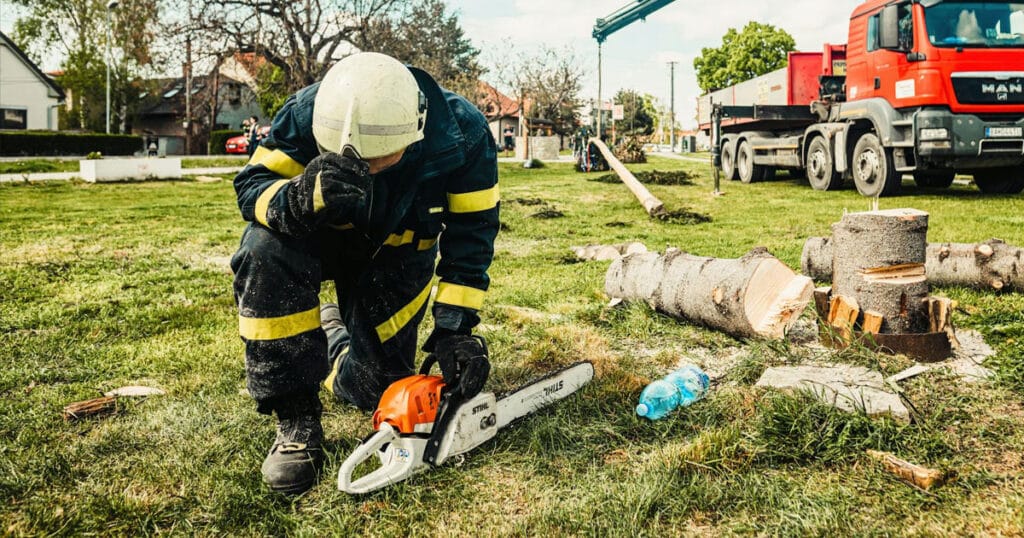
Chainsaw safety starts with checking everything before use. Skipping this step can cause accidents or damage. By checking your chainsaw and getting it ready, you can stay safe and work smoothly.
Chainsaw Inspection
Check chain tension and sharpness
A loose or dull chain can be dangerous. Make sure the chain fits tightly but still moves easily. Sharpen it often to keep it cutting well.
Look at the guide bar for damage
Check the guide bar for cracks or bends. A broken guide bar can cause uneven cuts or accidents. Replace it if needed to stay safe.
Test the chain brake
The chain brake is very important for safety. Turn it on and test it before starting the chainsaw. This makes sure it will stop the chain if a kickback happens.
Note: Checking your chainsaw often keeps it safe and saves money. The table below shows why inspections are important:
| Reason | Explanation |
|---|---|
| Safety Assurance | Inspections keep chains strong and lower accident risks. |
| Preventing Costly Downtime | Finding problems early helps fix them fast and avoid delays. |
| Compliance with Standards | Inspections follow rules and avoid legal trouble. |
Fuel and Lubrication
Use the right fuel mixture
Chainsaws need a special fuel mix to work well. Check the manual for the correct mix and use fresh fuel. The wrong mix can harm the engine.
Add chain oil
Oil reduces friction and keeps the chainsaw cool. Always check the oil level and add bar and chain oil before using it.
| Safety Measure | Description |
|---|---|
| Fuel Mixture | Check fuel levels and mix correctly |
| Consistent Lubrication | Ensure oil is added for smooth operation |
Functional Testing
Start the chainsaw in a safe spot
Pick a clear and steady place to start the chainsaw. Turn on the chain brake before pulling the starter cord. Never drop-start, as it’s unsafe.
Test throttle, chain brake, and stop switch
After starting, check the throttle for smooth speed changes. Turn the chain brake on and off to ensure it works. Test the stop switch to quickly turn off the chainsaw if needed.
Tip: Testing makes sure your chainsaw works safely and properly. The table below shows what to check:
| Hold the saw with both hands, gripping the handles. | Status | Comments |
|---|---|---|
| Starting the saw | Meets standards | Start with the chain brake on or firmly supported. No drop-starting allowed. |
| Grip | Meets standards | Hold the saw with both hands gripping the handles. |
| Firm footing & balance | Meets standards | Use the saw in a stable position to avoid losing balance. |
By following this checklist, you can make chainsaw use safer. Preparing well ensures your chainsaw is ready to work safely and effectively.
Safe Operating Techniques
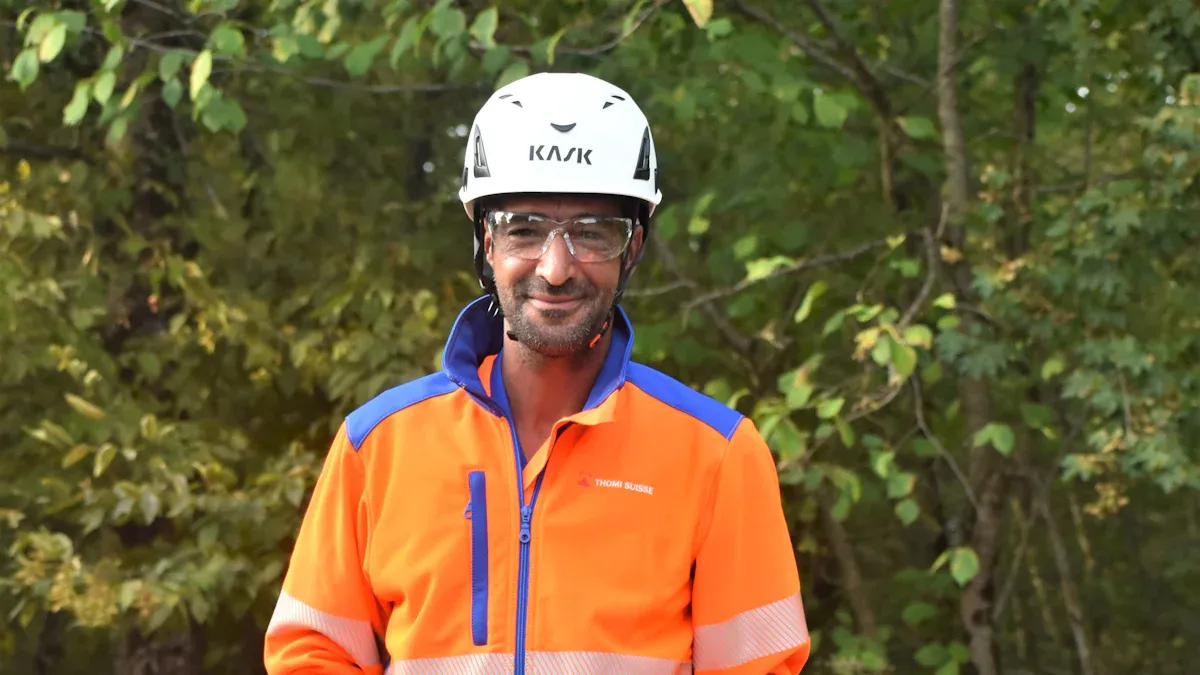
Chainsaw safety depends on how you handle it. Good techniques make work easier and lower accident risks. Learn proper handling, cutting, and how to avoid kickback for safer use.
Proper Handling
Hold the chainsaw with both hands
Always grip the chainsaw with both hands. Wrap your fingers around the handles tightly. This helps you stay in control, even if the saw shakes or hits something hard. A strong grip can prevent hand or wrist injuries.
Keep the chainsaw near your body
Hold the chainsaw close to your body. This keeps you balanced and reduces arm strain. Staying balanced helps you control the saw better. Take breaks often to avoid getting too tired, which can lead to mistakes.
Cutting Techniques
Stand firmly on the ground
Place your feet firmly before cutting. A steady stance helps you stay balanced, even on uneven ground. Don’t stretch too far, as it can make you lose balance and fall.
Don’t cut above shoulder height
Avoid cutting anything above your shoulders. This makes kickbacks more likely and harder to control. Use a different tool or change your position for high cuts.
Use the bumper spike for stability
The bumper spike is near the guide bar’s base. Push it against the wood to keep the saw steady. This helps you cut smoothly and with less effort.
Preventing Kickback
Know the kickback zone
The top tip of the guide bar is the kickback zone. If it touches wood or objects, the chainsaw can jerk back toward you. Always watch where the guide bar is to avoid this.
Keep the chain sharp and tight
A sharp, tight chain cuts better and lowers kickback risks. Dull or loose chains are harder to control and can snag, causing accidents.
Use a chainsaw with a chain brake
Modern chainsaws have a chain brake for safety. It stops the chain quickly if a kickback happens. Test the chain brake before starting your work to ensure it works properly.
Tip: Training helps you learn safe chainsaw use. Certification programs teach handling and how to avoid dangers. Many of the 25,000 yearly chainsaw injuries could be avoided by following these tips.
| Evidence Type | Description |
|---|---|
| Safety Practices | Shows why training, PPE, and safe cutting matter. |
| Training Requirement | Helps users understand tools and handle risks. |
| Injury Prevention | Explains how good habits stop most chainsaw injuries. |
By using these safe techniques, you can work confidently and avoid accidents.
Environmental Awareness
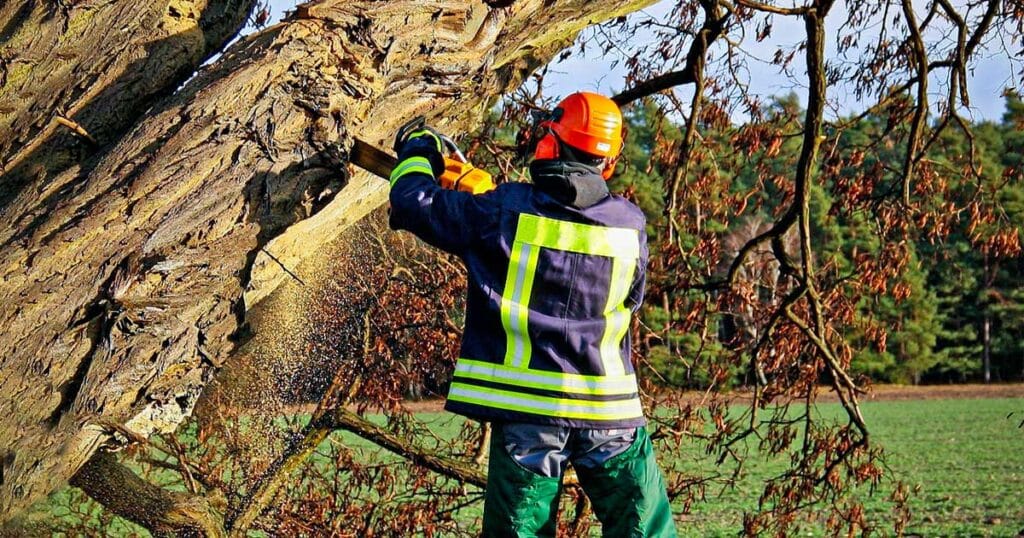
Chainsaw safety is not just about gear or skills. Knowing your surroundings is just as important. A safe work area lowers risks and makes tree-cutting easier. Let’s learn how to check your work area, think about the weather, and inspect trees.
Work Area Check
Remove clutter and obstacles
Before cutting, clear away tools, debris, or anything in your way. A clean area helps prevent accidents and keeps you focused. Look around often to spot unsafe things or actions. Talking with others can help find hidden dangers.
Watch for hazards like power lines
Check for dangers like power lines or uneven ground. Ignoring these can cause serious accidents. Carefully assess risks linked to your tasks. Looking at past accidents can also show common dangers.
Tip: Stay far from power lines. If a tree is near wires, call an expert.
Weather and Visibility
Don’t work in strong winds or rain
The weather affects chainsaw safety a lot. Strong winds can drop branches suddenly. Rain makes the ground slippery. Experts say bad weather increases risks. For example, reports show that poor weather lowers safety.
Use good lighting
Good lighting helps you see clearly for safe cuts. Work during daylight or use bright lights if needed. Poor lighting can lead to mistakes and accidents.
Note: Always check the weather before starting. Sudden weather changes can make things unsafe.
Tree Check
Look for dead branches or rot
Check the tree carefully before cutting. Look for signs of decay, like fungi or hollow spots. These can make the tree fall in unexpected ways. Experts use systems to check tree safety and health.
| Method | What It Does |
|---|---|
| Visual Tree Check | Looks at tree health and structure. |
| Stability Check | Tests how strong and stable the tree is. |
| Example: Home Yard | Fungi on an oak tree showed root problems, needing quick action. |
Plan where the tree will fall
Decide where the tree should fall. Clear the area of people, animals, or objects. Planning the fall direction avoids injuries and damage. Studies show that careful pruning lowers risks in busy areas like schools.
Reminder: Safety is more important than speed. Taking time to plan and check saves lives and property.
By staying alert to your surroundings, you can make chainsaw use safer for everyone.
Post-Operation Safety
Chainsaw safety doesn’t stop after the cutting is done. Shutting it down, carrying it safely, and storing it properly are important. These steps keep your chainsaw in good shape and ready to use again.
Shutting Down
Turn on the chain brake before shutting off
Always turn on the chain brake before turning off the chainsaw. This stops the chain from moving by accident and keeps you safe. Do this every time you pause or finish using the chainsaw.
Let the chainsaw cool before adding fuel
Never add fuel to a hot chainsaw. Wait until it cools completely to avoid fire risks. This simple step prevents burns and keeps you safe. Stay away from anything flammable while refueling.
Carrying the Chainsaw
Hold the bar pointing backward
When carrying the chainsaw, keep the bar pointing backward. Make sure the muffler faces away from your body. This lowers the chance of injury if you trip. Turn off the chainsaw if walking more than 50 feet.
Cover the chain with a scabbard
Always use a scabbard to cover the chain when carrying the chainsaw. This protects you from cuts and keeps the chain clean. It’s especially helpful in crowded or rough areas.
Tip: Use the chain brake when moving short distances with the chainsaw running. This adds extra safety.
Storage
Clean the chainsaw before storing
Clean your chainsaw well before putting it away. Remove sawdust, dirt, and oil to stop rust and keep it working well. Check for dull chains or loose parts during cleaning.
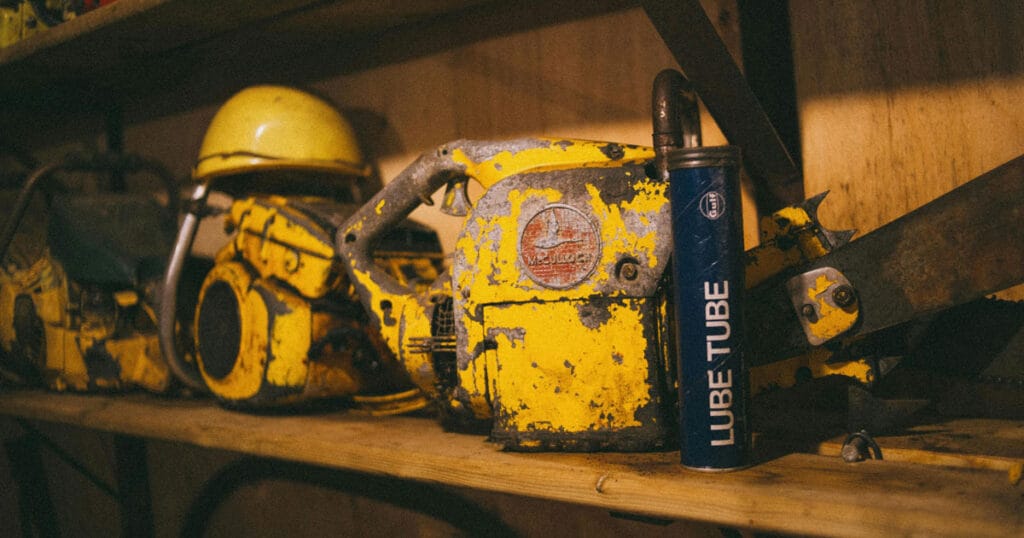
Store in a dry, safe place
Pick a dry and safe spot to store your chainsaw. Moisture can harm the engine and chain. A secure place keeps it away from kids or others who shouldn’t use it. Follow the maker’s storage tips to make it last longer.
Note: Keeping a maintenance log helps you track your chainsaw’s condition. This ensures it’s always safe and ready to use.
By following these steps, you can stay safe and make your chainsaw last longer.
Final Verdict
Chainsaw safety is very important to avoid getting hurt. Following safety steps lowers risks and keeps you safe. Wearing safety gear, checking your chainsaw, and using good methods help prevent accidents.
- Important Tips to Follow:
- Training teaches you how to spot and handle dangers.
- Checking your chainsaw often keeps it working safely.
- Safety gear protects you from bad injuries.
| Safety Step | How It Helps |
|---|---|
| Learning Proper Skills | Reduces how bad injuries |
| Using Safety Gear | Reduces how bad injuries can be |
| Following Safe Methods | Helps avoid getting hurt |
Chainsaws cause many injuries every year, but most can be prevented. By knowing the dangers and using smart practices, you can work safely. Focus on chainsaw safety and think about getting training to improve your skills.
FAQ
What should you do if the chainsaw chain gets stuck?
Turn off the chainsaw right away. Use a wedge or lever to loosen the chain gently. Never force it, as this can harm the guide bar or chain.
How often should you sharpen the chainsaw chain?
Sharpen the chain after using it for a few hours. If cutting becomes harder, it’s time to sharpen. A sharp chain works better and lowers accident risks.
Can you use a chainsaw in wet weather?
Don’t use a chainsaw when it’s wet outside. Rain makes surfaces slippery and raises accident risks. Wait for dry weather for better control and visibility.
What is the best way to prevent kickback?
Keep the chain sharp and tight. Don’t use the tip of the guide bar. Always use a chainsaw with a working chain brake to lower kickback risks.
How do you store a chainsaw safely?
Clean the chainsaw well and remove dirt. Store it in a dry, safe place away from kids. Cover the chain with a scabbard for extra safety.


